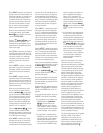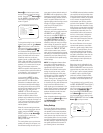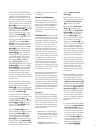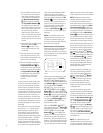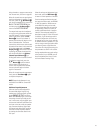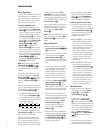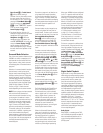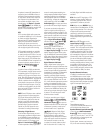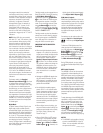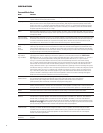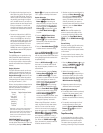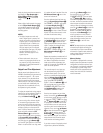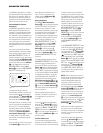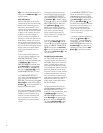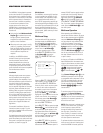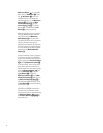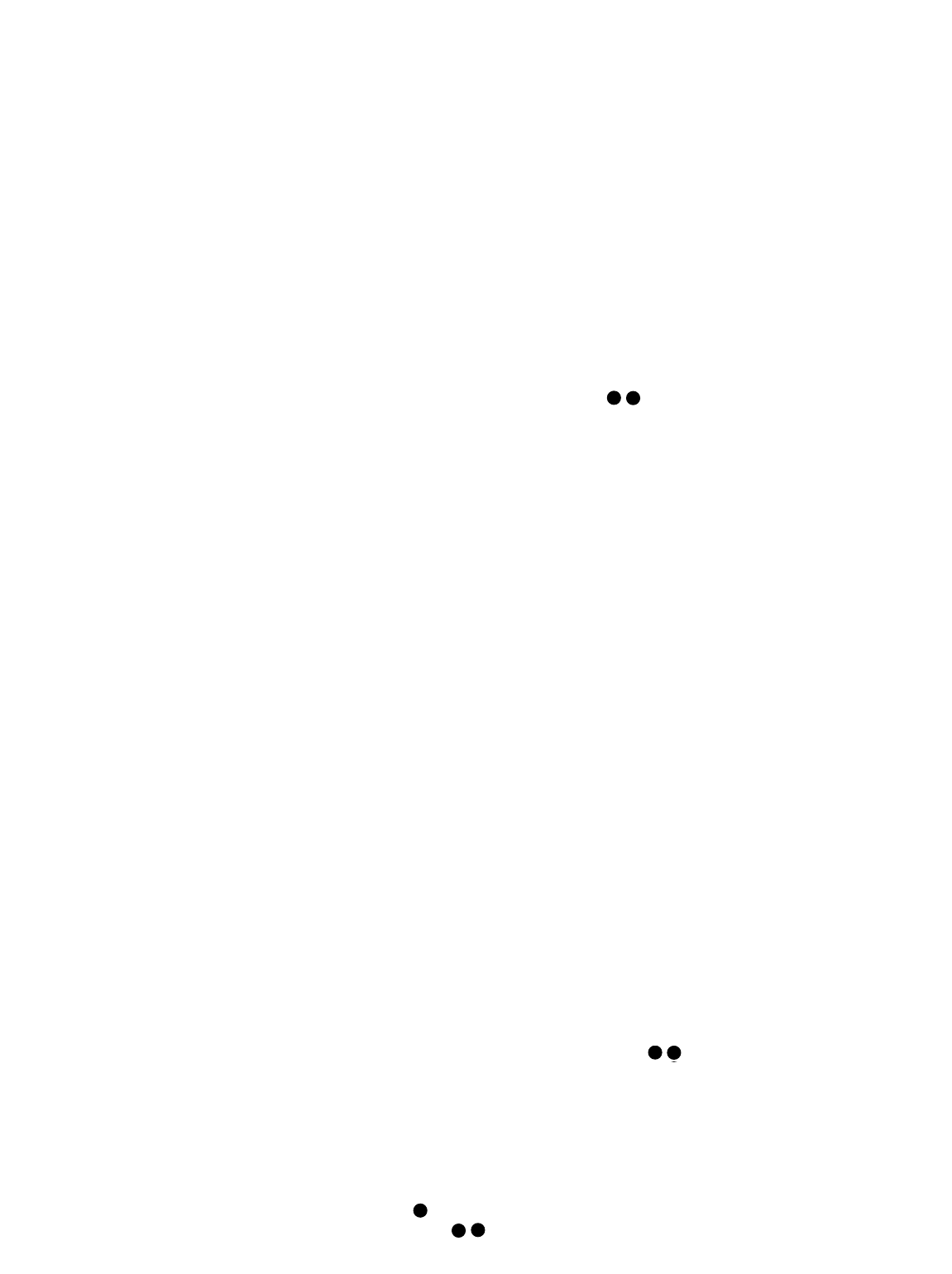
33
the program material, the method of
transmission and the way in which it was
encoded. When a digital signal is playing,
the letters in these indicators will light in
response to the specific signal being
received. It is important to note that
although Dolby Digital, for example, is
referred to as a “5.1” system, not all
Dolby Digital DVDs or programs are
encoded for 5.1. Thus, it is sometimes
normal for a DVD with a Dolby Digital
soundtrack to trigger only the “L” and “R”
indicators.
NOTE: Many DVD discs are recorded
with both “5.1” and “2.0” versions of the
same soundtrack. When playing a DVD,
always be certain to check the type of
material on the disc. Most discs show
this information in the form of a listing or
icon on the back of the disc jacket. When
a disc does offer multiple soundtrack
choices, you may have to make some
adjustments to your DVD player (usually
with the “Audio Select” button or in a
menu screen on the disc) to send a full
5.1 feed to the AVR580. It is also possible
for the type of signal feed to change dur-
ing the course of a DVD playback. In
some cases, the previews of special
material will only be recorded in 2.0
audio, while the main feature is available
in 5.1 audio. The AVR580 will automati-
cally sense changes to the bitstream and
channel count and reflect them in these
indicators.
The letters used by the
Speaker/
Channel Input Indicators
E also flash
to indicate when a bitstream has been
interrupted. This will happen when a digi-
tal input source is selected before the
playback starts, or when a digital source
such as a DVD is paused. The flashing
indicators remind you that the playback
has stopped due to the absence of a digi-
tal signal and not through any fault of the
AVR580. This is normal, and the digital
playback will resume once the playback
is started again.
Night Mode
A special feature of Dolby Digital is the
Night mode, which enables specially
encoded Dolby Digital input sources to be
played back with full digital intelligibility
while reducing the minimum peak level
by 1/4 to 1/3. This prevents abruptly loud
transitions from disturbing others, with-
out reducing the impact of the digital
source. The Night mode is available only
when Dolby Digital signals with special
data are being played.
The Night mode may be engaged when a
Dolby Digital DVD is playing by pressing
the
Night Mode Button l on the
remote. Next, press the
⁄
/
¤
Buttons
n to select either the middle range or
full-compression versions of the Night
mode. To turn the Night mode off, press
the
⁄
/
¤
Buttons n until the mes-
sage in the lower third of the video dis-
play and in the
Lower Display Line B
reads D-RANGE OFF.
The Night mode may also be selected to
always be on at either level of compres-
sion using the options in the
DOLBY
menu. See page 23 for information on
using the menus to set this option.
IMPORTANT NOTES ON DIGITAL
PLAYBACK:
• When the digital playback source is
stopped, or in a pause, fast forward or
chapter search mode, the digital audio
data will momentarily stop, and the
channel position letters inside the
Speaker/ Channel Input Indicators
E will flash. This is normal and does
not indicate a problem with either the
AVR580 or the source machine. The
AVR580 will return to digital playback
as soon as the data is available and
when the machine is in a standard
play mode.
• Although the AVR580 will decode virtu-
ally all current DVD movies, CDs and
HDTV sources, it is possible that some
future digital sources may not be com-
patible with the AVR580.
• Not all digitally encoded programs
contain full 5.1- or 6.1-channel audio.
Consult the program guide that accom-
panies the DVD or laser disc to deter-
mine which type of audio has been
recorded on the disc. The AVR580 will
automatically sense the type of digital
surround encoding used and adjust to
accommodate it.
• When a digital source is playing, you
may not be able to select some of the
analog surround modes such as Dolby
Pro Logic II, Dolby 3, Stereo, Hall,
Theater or Logic 7.
• When a Dolby Digital or DTS source
is playing, it is not possible to make
an analog recording using the
Tape
Outputs
and Video 1 or Video 2
Audio Outputs
. However, the
digital signals will be passed through
to the
Digital Audio Outputs gi.
PCM Audio Playback
PCM (Pulse Code Modulation) is the non-
compressed digital audio system used for
compact discs and laser discs. The digital
circuits in the AVR580 are capable of
high-quality digital-to-analog decoding,
and they may be connected directly to
the digital audio output of your CD or
LD player.
Connections may be made to either the
rear-panel
Optical or Coaxial Inputs
or the front-panel Digital Inputs
&*.
To listen to a PCM digital source, first
select the input for the desired source
(e.g., CD). Next press the
Digital Select
Button
Pq and then use the
⁄
/
¤
Buttons n on the remote, or the
‹
/
›
Selector Buttons )# on the front
panel, until the desired choice appears in
the
Main Information Display ˜.
During PCM playback, you may select
any Surround mode except Dolby Digital
or DTS.
MP3 Audio Playback
The AVR580 is one of the few receivers
equipped for onboard decoding for the
MP3 audio format used by computers and
portable audio devices. By offering MP3
decoding, the AVR580 is able to deliver
precise conversion of the digital signals
to an analog output, along with the bene-
fits of listening to the MP3 audio through
the AVR580’s high-current amplifier and
the speakers from your surround system,
rather than the smaller speakers and low-
powered amplifiers typically used with
computers.
To take advantage of the AVR580’s MP3
capabilities, simply connect the PCM out-
put of a computer’s sound card or the
PCM output of a portable digital audio
device to either the rear-panel
Digital
Inputs
or the front-panel Digital
Inputs
&*. When the digital signal is
available, the
Lower Display Line B
will indicate that an MP3 bitstream is
present, and the audio will begin playing.
NOTES:
• The AVR580 is only capable of playing
signals in the MP3 (MPEG 1/Layer 3)
format. It is not compatible with other
computer audio codecs.
34
31
34
31
39
36
33
continued on p. 35



